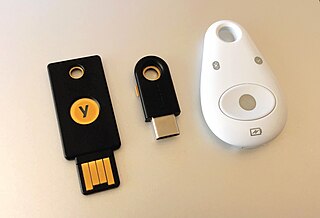
Computer security is the protection of computer software, systems and networks from threats that can lead to unauthorized information disclosure, theft or damage to hardware, software, or data, as well as from the disruption or misdirection of the services they provide.

Kerberos is a computer-network authentication protocol that works on the basis of tickets to allow nodes communicating over a non-secure network to prove their identity to one another in a secure manner. Its designers aimed it primarily at a client–server model, and it provides mutual authentication—both the user and the server verify each other's identity. Kerberos protocol messages are protected against eavesdropping and replay attacks.
A replay attack is a form of network attack in which valid data transmission is maliciously or fraudulently repeated or delayed. This is carried out either by the originator or by an adversary who intercepts the data and re-transmits it, possibly as part of a spoofing attack by IP packet substitution. This is one of the lower-tier versions of a man-in-the-middle attack. Replay attacks are usually passive in nature.

Privilege escalation is the act of exploiting a bug, a design flaw, or a configuration oversight in an operating system or software application to gain elevated access to resources that are normally protected from an application or user. The result is that an application or user with more privileges than intended by the application developer or system administrator can perform unauthorized actions.

Single sign-on (SSO) is an authentication scheme that allows a user to log in with a single ID to any of several related, yet independent, software systems.
Identity management (IdM), also known as identity and access management, is a framework of policies and technologies to ensure that the right users have the appropriate access to technology resources. IdM systems fall under the overarching umbrellas of IT security and data management. Identity and access management systems not only identify, authenticate, and control access for individuals who will be utilizing IT resources but also the hardware and applications employees need to access.
Self-service password reset (SSPR) is defined as any process or technology that allows users who have either forgotten their password or triggered an intruder lockout to authenticate with an alternate factor, and repair their own problem, without calling the help desk. It is a common feature in identity management software and often bundled in the same software package as a password synchronization capability.

OpenID is an open standard and decentralized authentication protocol promoted by the non-profit OpenID Foundation. It allows users to be authenticated by co-operating sites using a third-party identity provider (IDP) service, eliminating the need for webmasters to provide their own ad hoc login systems, and allowing users to log in to multiple unrelated websites without having to have a separate identity and password for each. Users create accounts by selecting an OpenID identity provider, and then use those accounts to sign on to any website that accepts OpenID authentication. Several large organizations either issue or accept OpenIDs on their websites.
A password manager is a software program to prevent password fatigue by automatically generating, autofilling and storing passwords. It can do this for local applications or web applications such as online shops or social media. Web browsers tend to have a built-in password manager. Password managers typically require a user to create and remember a single password to unlock to access the stored passwords. Password managers can integrate multi-factor authentication.
A number of computer operating systems employ security features to help prevent malicious software from gaining sufficient privileges to compromise the computer system. Operating systems lacking such features, such as DOS, Windows implementations prior to Windows NT, CP/M-80, and all Mac operating systems prior to Mac OS X, had only one category of user who was allowed to do anything. With separate execution contexts it is possible for multiple users to store private files, for multiple users to use a computer at the same time, to protect the system against malicious users, and to protect the system against malicious programs. The first multi-user secure system was Multics, which began development in the 1960s; it wasn't until UNIX, BSD, Linux, and NT in the late 80s and early 90s that multi-tasking security contexts were brought to x86 consumer machines.
In computer systems, an access token contains the security credentials for a login session and identifies the user, the user's groups, the user's privileges, and, in some cases, a particular application. In some instances, one may be asked to enter an access token rather than the usual password.
Security Support Provider Interface (SSPI) is a component of Windows API that performs security-related operations such as authentication.

Multi-factor authentication is an electronic authentication method in which a user is granted access to a website or application only after successfully presenting two or more pieces of evidence to an authentication mechanism. MFA protects personal data—which may include personal identification or financial assets—from being accessed by an unauthorized third party that may have been able to discover, for example, a single password.
In computer security, pass the hash is a hacking technique that allows an attacker to authenticate to a remote server or service by using the underlying NTLM or LanMan hash of a user's password, instead of requiring the associated plaintext password as is normally the case. It replaces the need for stealing the plaintext password to gain access with stealing the hash.
Xceedium, Inc., was a network security software company providing privileged identity and access management solutions which was subsequently acquired by CA Technologies. Their software is used to control and manage the risks that privileged users, privileged accounts and privileged credentials pose to systems and data.

Netwrix is a Frisco, Texas–based private IT security software company that develops software to help companies identify and secure sensitive data and assist with compliance auditing. After eight acquisitions the company's team geographically expanded to Latin America, UK, Germany, France, Asia, US as well as other countries. The company's flagship products are Netwrix Auditor and Netwrix Enterprise Auditor that help information security and governance professionals manage sensitive, regulated and business-critical data.
Customeridentity and access management (CIAM) is a subset of the larger concept of identity access management (IAM) that focuses on managing and controlling external parties' access to a business' applications, web portals and digital services.
Internet security awareness or Cyber security awareness refers to how much end-users know about the cyber security threats their networks face, the risks they introduce and mitigating security best practices to guide their behavior. End users are considered the weakest link and the primary vulnerability within a network. Since end-users are a major vulnerability, technical means to improve security are not enough. Organizations could also seek to reduce the risk of the human element. This could be accomplished by providing security best practice guidance for end users' awareness of cyber security. Employees could be taught about common threats and how to avoid or mitigate them.
Privileged Access Management (PAM) is a type of identity management and branch of cybersecurity that focuses on the control, monitoring, and protection of privileged accounts within an organization. Accounts with privileged status grant users enhanced permissions, making them prime targets for attackers due to their extensive access to vital systems and sensitive data.
Namespace security is a digital security discipline that refers to the practices and technologies employed to protect the names and identifiers within a digital namespace from unauthorized access, manipulation, or misuse. It involves ensuring the integrity and security of domain names and other digital identifiers within networked environments, such as the Internet's Domain Name System (DNS), software development namespaces and containerization platforms. Effective namespace security is crucial for maintaining the reliability and trustworthiness of brands and their digital services and for preventing cyber threats including impersonation, domain name hijacking or spoofing of digital identifiers like domain names and social media handles.






